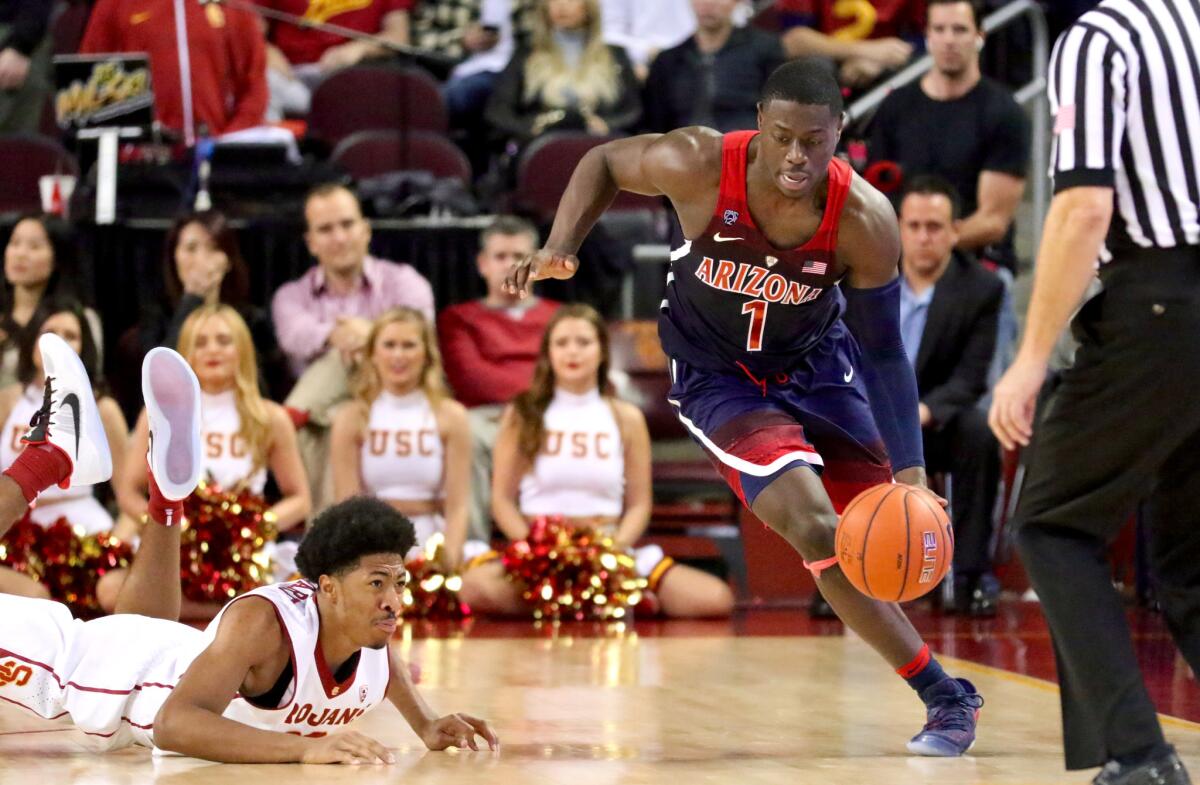After a 20-minute respite from the drought, USC hopes its shooting woes are gone for good

- Share via
USC guard Elijah Stewart hopped on one foot and leaned back like a baseball player willing his hit to stay fair.
By the time his shot arced toward the rim, Stewart, a junior, had gone two games without making a three-pointer — the first time he’s done so since his freshman season. He’d made just four three-pointers in his first six conference games.
His extended shooting drought was unusual, but he has company on USC, where the poor shooting has been contagious. No guard has made more than 40% of his field goals during Pac-12 Conference play. Take away forward Chimezie Metu, the only player who has displayed any sort of efficiency, and USC has shot just 37% in conference, a brutally low figure.
Now, at the end of the first half against Arizona, Stewart’s three-pointer finally splashed in.
It foretold a hot second half, when USC made half of its shots. Stewart five of nine three pointers. It did not ultimately lead to victory Thursday. But did it signal that USC’s slump was about to break?
“I hope so,” Coach Andy Enfield said. “We know they’re not going to shoot that poorly for that long.”
The timing may be ideal. On Sunday, USC (16-4, 3-4 in the Pac-12) hosts Arizona State (9-10, 2-4), the worst defensive team in the league by field-goal percentage allowed. Opponents have made almost 49% of their shots against the Sun Devils.
The Trojans’ struggles have extended throughout their seven conference games. They have avoided catastrophe, but they lost two winnable games at home against California, when they made less than half of their free throws, and against Arizona.
Nearly every player has been affected, with the exception of Metu. Stewart, a shooting guard, has made 37% of his shots. Shaqquan Aaron, a wing, has made 28%.
“Usually it’s one or two players, and they’ll snap out of it,” Enfield said. “It’s very unusual.”
The problem is vexing because no one can find an explanation.
“I’ve broken down every offensive possession in the last seven games,” Enfield said. “And we’re just missing open shots.”
Stewart hoped Thursday’s second half provided a blueprint for emerging from the malaise. He said that USC began its run when “we got easy transition buckets that led to layups and free throws.”
USC can use the momentum of its defense to restart its idling offense, guard Jordan McLaughlin said. A defensive stop, he said, can lead to fastbreak scores. And easy scores can build confidence.
“Once you see the ball go through the net a couple times in the game, the rim starts opening up a little bit wider,” McLaughlin said. “Shots will start falling for us. We all know we can shoot.”
NEXT UP
USC VS. ARIZONA STATE
When: Sunday, 5:30 p.m.
Where: Galen Center.
On the air: TV: ESPNU. Radio: 710.
Update: USC trailed by as many as 23 points in the second half against Arizona before mounting a furious comeback that the Wildcats didn’t halt until about 30 seconds remained. Arizona made a banked-in three-pointer and won, 73-66. For the first time in more than a year, USC has a losing record at home in conference play. Arizona State, coming off a difficult stretch, offers a good opportunity to reset. The Sun Devils have lost three straight games, to Utah, Arizona and UCLA. They have given up nearly 94 points per game in that span. Arizona State’s offense has been harder to contain. Torian Graham leads the team with 18.5 points per game, Tra Holder contributes 17.2 and Shannon Evans II has averaged 15 points per game.
Follow Zach Helfand on Twitter @zhelfand
Fight on! Are you a true Trojans fan?
Get our Times of Troy newsletter for USC insights, news and much more.
You may occasionally receive promotional content from the Los Angeles Times.




